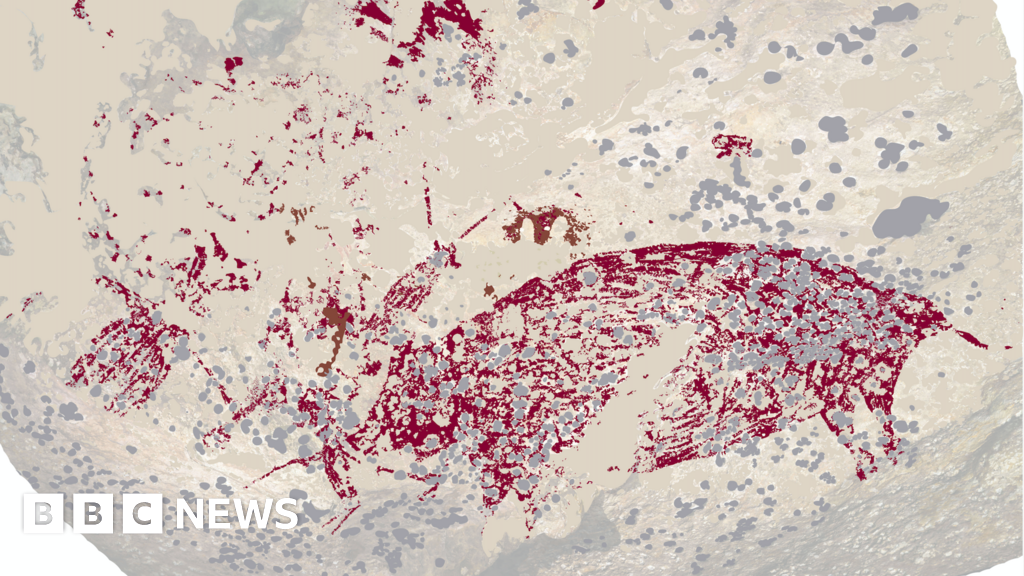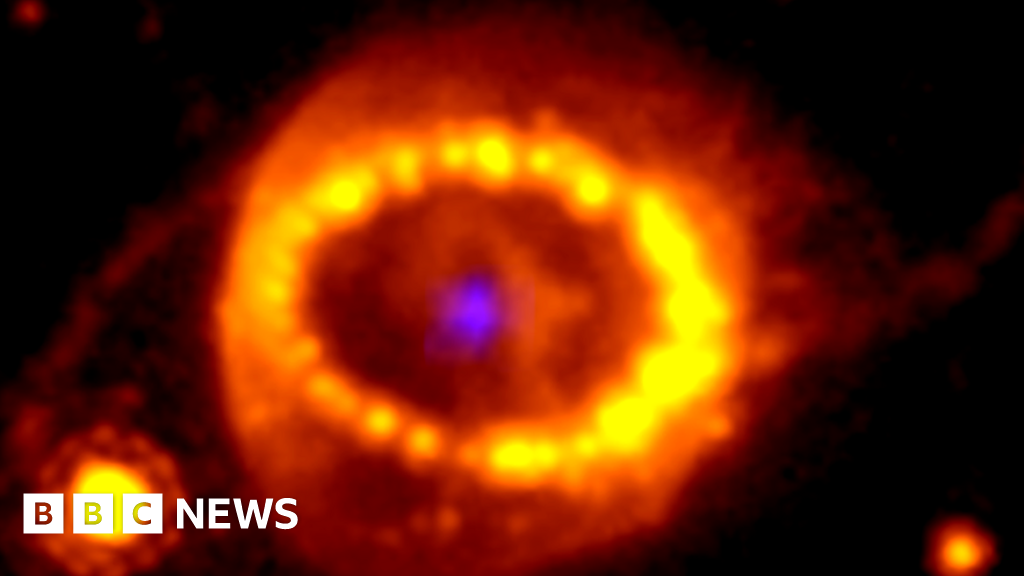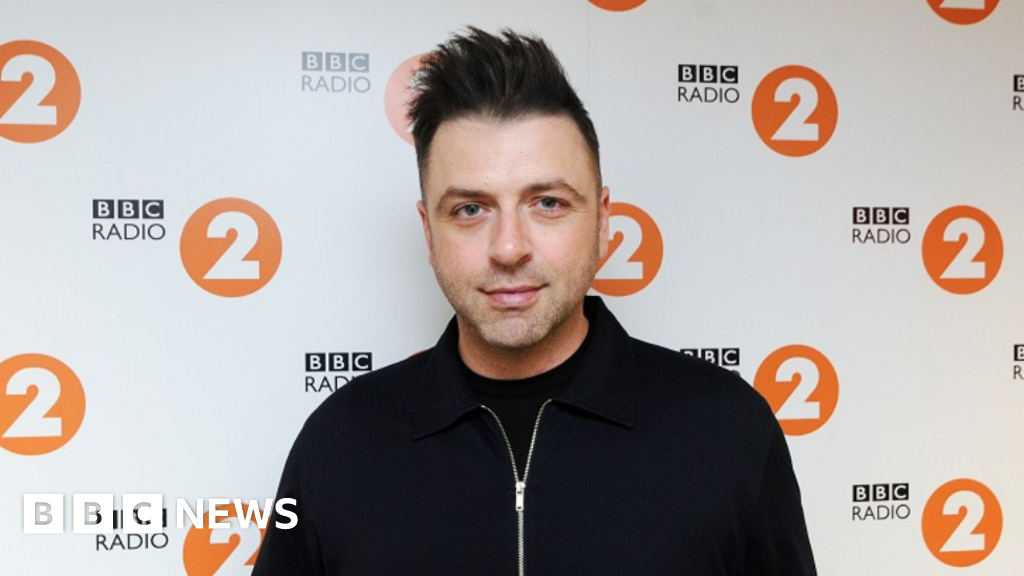- Image caption,

Image source, Dr Neil Clark
Parts of the Isle of Skye have been found to have fossils key to understanding dinosaurs of the Middle Jurassic period.
Steven McKenzie
BBC Scotland News
Kirsty Campbell
BBC Naidheachdan
Reporting from
Isle of Skye
Forty years ago a scientific paper written by a young student revealed for the first time the presence of dinosaur fossils on the Isle of Skye.
Since then, a whole host of discoveries have been made including a "dinosaur disco" made up of dozens of footprints, a bone from an ancestor of the T-rex and the fossils of winged reptiles called pterosaurs.
Who found Skye's first dinosaur fossil?
Image source, Julian Andrews
Image caption,Prof Julian Andrews in a picture from his 1982 field trip to Skye
It was 1982 and 22-year-old first-year Leicester University PhD student Julian Andrews was on a field trip to Skye's rugged north coast.
The young scientist was not looking for dinosaurs.
He was seeking to better understand the environmental conditions the island's ancient Middle Jurassic sedimentary rocks were formed in.
"It was towards the end of the morning and, as you do when you are in the field, I walked away from where we were working to look at the whole context," says Andrews, today an emeritus professor at the University of East Anglia.
"I put my hand on a block of limestone, just to steady myself.
"I looked under my hand and thought 'Oh, that's funny. There's sort of a lump there'."
Seeing the shape of three toes he realised he had stumbled on a dinosaur footprint.
Earlier in the trip, the scientist's supervisor, John Hudson, had said no dinosaur fossils had been found on Skye - despite the rocks being the right kind for such finds.
Prof Andrews said: "I went back to him and I said: 'Did you say no-one's ever found any dinosaur remains on Skye?'
"'Well, I think we have now'."
What happened to the 1982 find?
Image source, Julian Andrews
Image caption,Prof Andrews' photograph of the dinosaur footprint
Prof Andrews and his supervisor measured and recorded the fossil and the rock it was in - and then had to leave it where it was.
"It was on an absolutely enormous block of rock, and it was in a very remote part of the coast," says Prof Andrews.
"It was very unlikely that anyone else would find it because it was it was not easy to find and get to."
The discovery remained a secret until 1983 when experts arrived to remove it. Unfortunately the fossil split in two.
Prof Andrews says fish boxes that had washed up as a marine litter on the shore were used to carry the two pieces off the beach.
It was eventually taken to The Hunterian museum at Glasgow University for analysis.
In 1984 - 40 years ago - Prof Andrews' paper on the fossil was published.
It was confirmation of Scotland's first-ever dinosaur fossil.
More discoveries - and a mystery package in the post
Image source, Dr Neil Clark
Image caption,Dr Neil Clark, of the University of Glasgow, with a Skye fossil footprint
It would be 10 years before the next dinosaur find was made - a bone from an Early Jurassic theropod in Heast.
Dr Neil Clark, curator of palaeontology at The Hunterian, recalls how part of another bone was uncovered by BP oil workers on a field trip in 1994.
"There were chisel marks in the rock to suggest someone had found another bit and then ran off with it," says Dr Clark.
"We decided to have a closer look to see where the missing piece was.
"There was some press coverage about the dinosaur bone - and the pillaging of the rocks of Skye."
Soon after, a package arrived anonymously in the post for Dr Clark.
Inside, carefully wrapped in shredded invoices, was the missing piece of bone.
The third and final part of the bone was later found on Skye by local restaurant owners.
Analysis identified the bone as part of a leg of a sauropod - large dinosaurs with long necks.
Another bone found by Dr Clark was later identified as belonging to an ancestor of the T.rex.
Other significant finds include:
2002 - Local hoteliers Paul and Cathie Booth discover footprints at Staffin
2006 - A fossil is found during a dig. Almost 20 years later it has been identified as a pterosaur.
2015 - Palaeontologists Steve Brusatte and Tom Challands stumbled across more than 100 footprints and handprints left by giant long-necked dinosaurs. University of Edinburgh's Prof Brusatte said the site resembled a "dinosaur disco".
2017 - Student Amelia Penny spots a pterosaur skull sticking out of rock north of Portree. The creature is given the Gaelic name Dearc sgiathanach
How old are Skye's dinosaur fossils?
Image source, Dr Neil Clark
Image caption,A sauropod footprint on Skye
They are from the Middle Jurassic - which was between 162 million to 175 million years ago.
Palaeontologists say it was period of time when there was a massive diversification in dinosaurs.
There has been very little evidence of dinosaurs found elsewhere in Scotland, largely because the rocks are much older than the time when the reptiles ruled the Earth.
What do islanders think of their 'Dinosaur Isle'?
Dugald Ross started a fossil museum when he was teenager in 1976
Dugald Ross set up a fossil museum in Staffin in 1976 when he left school at 15.
His collection at the time included ammonites, marine animals with a coiled shell.
Over the years, he has been involved in work to uncover dinosaur footprints and extract bones - including the 1994 one found by the oil workers.
Mr Ross is proud of Skye's importance to the understanding of what life was like in the Middle Jurassic.
"The Isle of Skye is of particular significance because of the age of the fossils," he says.
"That period is not well represented on a worldwide basis, and that is why there is international attention.
"Very few places in the world have that age of rock on the surface."
Image source, Cathie Booth
Image caption,Paul and Cathie Booth with a dinosaur fossil footprint found in 2002
Cathie and Paul Booth live in Highland Perthshire but were hoteliers on Skye when they made their fossil discoveries in January 2002.
Mrs Booth made her find walking the family's dog in Staffin Bay.
"It had been really stormy and high tides the day before and the sandy bay was all churned up and covered in stones," she says.
"One of the loose stones had some interesting markings."
She sent a photograph to Dr Clark who confirmed it was a footprint of a plant-eating dinosaur.
"He said it was an amazing find and that there might well be a lot of interest, but I was still amazed to be contacted by media, radio and TV from the UK and all over the world at the time," Mrs Booth said.
"Exiting times for us."
Mr Booth, whose discoveries include an 18-footprint trackway and bone, said: "It seems amazing now that some things we discovered during the course of living, working and raising a family in a small corner of Scotland have become so important in generating a better understanding of life during this Middle Jurassic period."

 4 months ago
27
4 months ago
27








 English (US) ·
English (US) ·